Stance
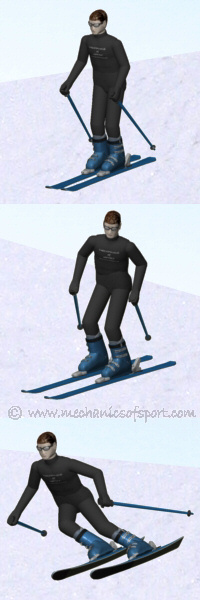
A stance is a position for the body, that gives you all the movement and flexibility needed to perform whatever manoeuvre you are making. In some of the ski technique sections the stance has been explained again, specifically to the manoeuvres being described. Here the elements of a parallel skiing stance are explained, although the principals can be applied to any manoeuvre.
A stance is generally thought of as a set position, but in skiing we are always changing direction and speed and do not stay in the same positions for very long. This means that our stance must constantly change, so it is best explained as a variable position that changes depending on variables like direction, speed and the angle of the slope, with other elements added when necessary.
The eventual outcome is to make something more like a formula to work out what stance you should have in each phase of a manoeuvre. Although it is very simple in the end, there are many parts to a stance that need to be explained.
Below the key elements to a stance are listed, with some of the reasons for them and things they imply, then below that there is an explanation of how a stance is composed from the bottom up.
A good stance must:
- Be able to absorb bumps through the legs and allow the body to flex. This means that the knees must be bent, as well as all other joints. There should be no joints that are straight as they must all be able to move in both directions.
- Have the skis in the correct position. The correct position for the skis comes from the direction of travel and manoeuvre being performed, as will be explained further down.
- Match the position of the body to the skis. The bodies position must be matched to the skis to allow the flexibility and absorption as explained before.
- Give you a good view of where you are going to go. This means that you must be able to look in the direction you are going and down the slope, although this comes naturally with how the body is matched to the skis.
- Put the bodies weight in the right position. This comes mainly from the waist leaning the body forwards or sideways.
- Be comfortable. Although this is very important you will find that generally the most comfortable positions are the positions that allow the body to match the skis and flex the most, it actually comes through the other criteria.
- Allow the body to change easily into the next stance as you change direction/speed. Again since all stances follow the same rules this happens naturally.
- Conserve energy. A good stance will be energy efficient, as it makes manoeuvres more effective and enables the skier to ski for longer.
To explain how a stance is composed we must start from the bottom and go up, as it is the skis and slope that do the work in the end and everything must be matched to them.
Straight Forward Stance
The first variables are direction of travel, and steepness of the slope. If you are going straight down the slope the skis will be parallel and at the same height, and the entire stance is very simple. Skis hip width apart, the same weight on each ski, knees bent to absorb bumps, the body leaning slightly forward to put your weight over the middle of the skis (and making it able to flex in both directions), looking forward with your arms out to the sides slightly in front of you with the elbows slightly bent. The amount of forwards lean will obviously change depending on how steep the slope is, so that the centre of gravity is kept over the middle of the ski.
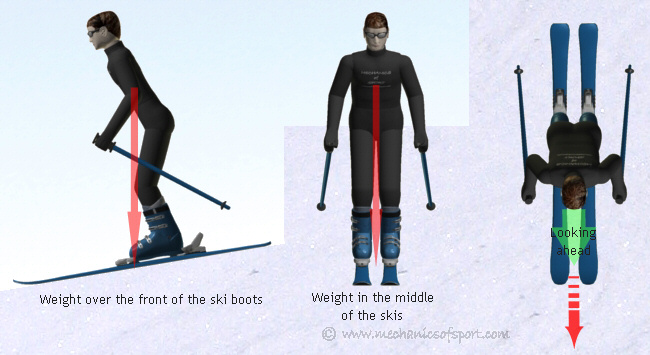
As you come down a slope where the gradient decreases, you will need to lean forwards to keep your weight over the middle of the skis, as shown in the diagram below. If you do not lean forwards your weight will come back giving you less control of the skis. You also need to lean backwards slightly if the gradient increases, to keep the weight over the middle of the skis, but this should not be worried about as it will happen naturally, and is not such a problem if it isn't done.
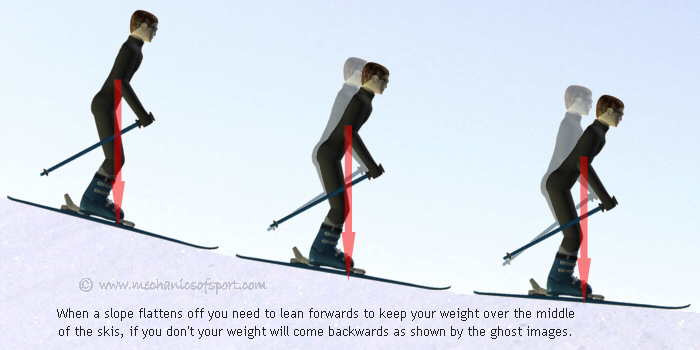
Traversing Stance
However if you are going across the slope or are leaning over from pulling G-forces, as you will spend most of your time doing, the ski on the downhill side (downhill ski) or outside of the turn (outside ski) will be lower (relative to your body) than the other ski (uphill ski or inside ski). As shown in the diagram.
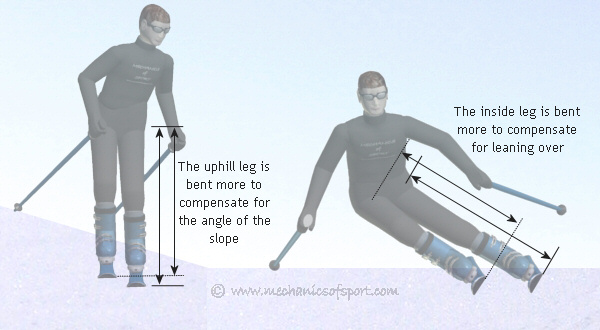
In ski boots though you can not move you ankles much, and the only way to make one ski higher than the other is to bring the uphill/inside knee forward (as shown in the animation on the right). This leaves you with the uphill/inside ski slightly in front of the downhill/outside ski . Also the steeper the slope is (or the more you are leaning over) the lower/further away the downhill ski will be, and the further forward the uphill/inside ski will come. The skis should still be hip width apart for going across the slope, but for leaning over they will get further apart the more you lean, even though the legs stay hip width apart. Hip width is the correct distance apart to have the skis, as it keeps their angle to the snow the same, while leaving enough movement in the legs to roll your knees, and put the skis on their edges. As before both knees must always be bent to absorb bumps.
As for the upper body, we have our feet one in front of the other and the position that allows the most movement, flexibility and comfort is the turn the body so that the shoulders are inline with the feet. This means that the body is not looking down the skis, it is slightly twisted towards the fall line. It also makes it so that our head is in a good position to look at where we are going and down the slope. This element of the stance is very often missed by skiers, and one of the easiest ways to tell how good a skier is just by looking at them quickly, is to see if they have their body turned towards the fall line or not.
The upper body also needs to be positioned so that our weight is transferred to the downhill/outside ski, and to the middle of the ski lengthways. When just going across the slope without pulling any G-forces we simply lean forwards a bit to put our weight in the middle of our skis (longitudinal weight distribution), and to the downhill side a bit to put our weight over the downhill ski (lateral weight distribution). When all of this is put together, it produces the following position.
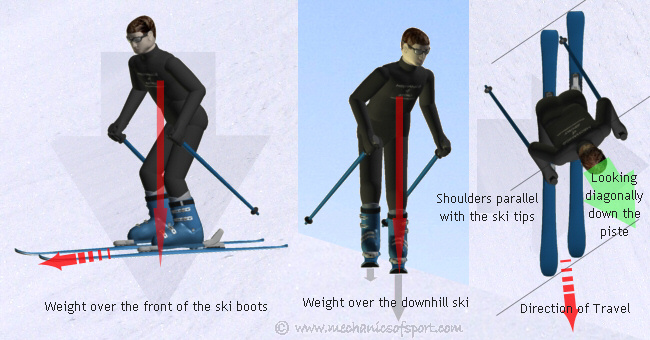
As shown in the animation below, if the angle of the slope gets steeper, the uphill ski will have to be raised more. Raising the ski will bring it further forwards, so the shoulders have to turn more to maintain the correct position.
Leant Over Stance
When leant over though the body must be moved in the same way as before, but so that the weight is transferred into the outside ski through the resultant force from gravity and the turning force.
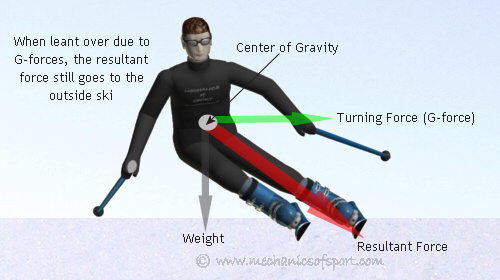
For carving the body is not twisted to the side, as the direction you are traveling is along the skis. The shoulders should be brought flat to the direction of the skis, so that you are looking down the length of the skis.
Other Stances
When we are performing manoeuvres like short turns and mogul skiing, conserving energy comes in to play a lot, and we want to perform these manoeuvres with as little movement as possible from the upper body. To do this we try to keep the body from the waist up pointing straight down the slope, just changing the angle of the hips, legs and skis to the slope to perform the manoeuvres. This uses less energy as there is less mass that needs to be moved around to make each turn, making us able to turn more quickly and efficiently.
In powder we need to keep our skis above the snow, which means we need to bring our weight back slightly when we start off to keep the ski tips above the snow, once you have the right speed to keep the skis afloat though, you should have your weight in the middle of the skis again. In some conditions you do have to lean back slightly all the time, but this does not happen so often.
On to the Edge Pressure section.